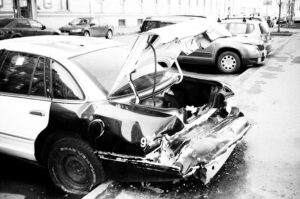Contents
Why is the Paint Peeling off My Bumper?
You’ve probably noticed it, that unsightly sight when you look at your car – the paint peeling off your bumper. It’s like your car’s way of telling you it’s having a bad day. But why is this happening?
In this article, we’re going to dive deep into the world of bumper paint peeling. We’ll explore what causes it, how to spot the signs, the consequences of ignoring it, and most importantly, how to prevent it. So, buckle up, and let’s get started on this automotive adventure!
Understanding Bumper Paint Peeling
What is Bumper Paint Peeling? Bumper paint peeling is like your car’s version of a bad hair day. It’s when the paint on your bumper starts to come off in flakes or chips. You might see patches of bare metal or primer, and it can make your car look like it’s seen better days. It’s not just a cosmetic issue; it can lead to bigger problems if left unaddressed.
Imagine this: You’re strolling through a parking lot, and you spot a car with its bumper paint peeling off like a sunburned tourist’s skin after a day at the beach. It’s not a pretty sight, and you can’t help but wonder, “What went wrong there?”
Differentiating It from Other Paint Problems Before we dive into the causes, let’s make sure we’re talking about the right thing. Bumper paint peeling is not the same as fading or cracking. Fading happens when the color loses its vibrancy, making your car look dull and tired. Cracking, on the other hand, is when the paint splits into tiny lines, reminiscent of a dried-up riverbed. Peeling, well, it’s like it’s lifting off the surface, almost as if your bumper is trying to escape.
Picture this: You’re comparing two cars, both a vibrant shade of blue. The first one has that smooth, shiny finish that looks like it just rolled off the showroom floor. The second one, unfortunately, has paint that’s peeling off in chunks, leaving behind a jagged and uneven texture. It’s like comparing a freshly baked cake to one that’s been nibbled on by hungry little critters.
Main Causes of Bumper Paint Peeling
Environmental Factors
UV Radiation: Think of the sun as your car’s arch-nemesis. Over time, exposure to UV rays can break down the paint’s protective layer, making it prone to peeling.
For instance, imagine you have two identical cars. One is parked in a garage most of the time, shielded from the sun’s harsh rays, while the other sits outside, exposed to the scorching sun day in and day out. After a few years, the difference is striking. The car exposed to the sun has its paint peeling off, while the one in the garage still shines like new.
Temperature Fluctuations: Hot and cold weather can cause your car’s materials to expand and contract. This constant movement can lead to paint peeling.
Think about it this way: Your car sits out in the freezing cold all night. When you start it up in the morning and drive it into the warm sunlight, the sudden change in temperature causes the materials to expand rapidly. Over time, this expansion and contraction can weaken the paint’s grip, leading to peeling.
Humidity and Moisture: Water is great for quenching your thirst, but it’s not your car’s friend. Moisture can seep under the paint and create bubbles, which eventually lead to peeling.
Imagine you live in a coastal town where the air is heavy with moisture. Your car faces the ocean breeze every day. The salt-laden air, combined with the moisture, can creep under your bumper’s paint. It’s like a silent invader, slowly but steadily causing the paint to peel away, just like the layers of an onion.
Poor Paint Application
Factory Application Issues: Sometimes, it’s not your fault at all. If your car’s paint was applied poorly at the factory, it’s more likely to peel.
Let’s say you and your neighbor both bought the same car model, but yours was manufactured on a Friday afternoon when the workers might have been a bit distracted, while your neighbor’s car was made on a Tuesday morning when everyone was fresh and focused. Your car might be more prone to paint issues like peeling because of the hurried application.
DIY Paint Jobs: DIY is fantastic for crafts, but when it comes to painting your car, it can be a recipe for disaster. Uneven coats or improper priming can lead to peeling.
Imagine you decide to take matters into your own hands and repaint your bumper in your garage. You might miss crucial steps in the process, like sanding and priming. Fast forward a few months, and you notice the paint is starting to peel off in patches. Your DIY adventure turned into a paint peeling predicament.
Road Debris and Physical Damage
Stone Chips and Impacts: Your bumper takes the hit when you drive over debris or get bumped in a parking lot. These impacts can weaken the paint’s adhesion.
Picture this: You’re on a road trip, cruising down the highway, and suddenly, a rock kicked up by a passing truck strikes your bumper. You might not notice any immediate damage, but over time, that impact weakens the paint’s grip, making it more likely to peel.
Scratches and Abrasions: Whether it’s from a rogue shopping cart or a low-speed collision, scratches can compromise the paint’s integrity.
 Imagine you’re at the grocery store, and as luck would have it, a shopping cart with a mind of its own collides with your bumper. The impact leaves behind a scratch. At first, it seems harmless, but if left untreated, that scratch can be the starting point for paint peeling.
Imagine you’re at the grocery store, and as luck would have it, a shopping cart with a mind of its own collides with your bumper. The impact leaves behind a scratch. At first, it seems harmless, but if left untreated, that scratch can be the starting point for paint peeling.
Chemical Exposure
Harsh Cleaners and Chemicals: Cleaning your car is essential, but using harsh chemicals can strip away the paint’s protective layers, making it vulnerable to peeling.
Think about this scenario: You’re determined to make your car shine, so you grab a powerful cleaner from the store. Little do you know, that cleaner is too harsh for your car’s paint. After a few rounds of cleaning, you notice the paint starting to peel off. It’s like using a sledgehammer to crack a nut.
Road Salts and Contaminants: During winter, road salts and contaminants can accumulate on your bumper. These substances are not paint-friendly.
Imagine it’s wintertime, and your city is salting the roads to keep them ice-free. As you drive through these salted streets, your bumper collects the salty residue. Over time, the salt eats away at the paint, causing it to peel off like old wallpaper.
Age and Wear
Natural Aging of Paint: Like everything else, paint ages. Over time, it can lose its grip on the surface.
Consider this: You’ve had your car for a few years, and it’s been through rain, sun, and snow. It’s only natural that the paint will age. As it does, it gradually loses its adhesion, making it more susceptible to peeling.
Wear and Tear Over Time: Everyday wear and tear, including regular driving, can gradually wear down the paint.
Think of your bumper’s paint as a pair of jeans. The more you wear them, the more they fade and develop little frayed edges. Similarly, the more you drive your car and expose it to the elements, the more the paint can wear down, eventually leading to peeling.
Signs of Bumper Paint Peeling
Spotting bumper paint peeling isn’t rocket science; you just need to know what to look for:
- Visual Cues: Check for areas where the paint looks like it’s bubbling, lifting, or chipping. It’s as obvious as a neon sign on a dark night.
- Texture and Feel: Run your fingers over the bumper. If it feels rough or uneven, that’s a sign of trouble. It’s like the difference between stroking a silky cat and petting a porcupine.
- Bubbling or Blistering: Little bubbles forming under the paint are a clear indicator of peeling. It’s like a soda can about to burst – a sign that something’s not right.
Consequences of Ignoring Bumper Paint Peeling
Ignoring this peeling predicament can lead to more than just a cosmetic eyesore. Here’s what could happen:
Corrosion and Rust: When the paint’s protective layer is compromised, your bumper is more susceptible to rust and corrosion, which can spread and cause structural damage.
Imagine you’re a detective in a crime movie, and the victim is your car’s bumper. The peeling paint is like the first sign of trouble – a small clue that something sinister is lurking beneath the surface. If you ignore it, the corrosion and rust will be the plot twist that leaves your bumper in ruins.
Increased Vulnerability to Further Damage: Peeling paint leaves your bumper vulnerable to scratches, dents, and more peeling, creating a vicious cycle of deterioration.
Think of your bumper as a knight in shining armor. If the armor is damaged, the knight is more susceptible to attacks. In the same way, a bumper with peeling paint is defenseless against the hazards of the road.
Reduced Resale Value: If you plan to sell your car in the future, that peeling paint can significantly reduce its resale value. Nobody wants a car that looks like it’s falling apart.
Imagine you’re trying to sell your car, and a potential buyer takes one look at the peeling bumper. They might think, “If the owner didn’t take care of the bumper, what else is neglected?” Your car’s resale value takes a nosedive, and you’re left with a lower offer than you expected.
Aesthetic Degradation: Let’s face it; a peeling bumper just doesn’t look good. Your car’s appearance takes a hit, and that’s something no car owner wants.
Picture this: You’re driving down the street, and you spot a car with a bumper that looks like it’s been through a war zone. The peeling paint, the bare metal – it’s like a scarred warrior on the battlefield. It’s not a sight you’d want for your own car.
Preventing Bumper Paint Peeling
Now that you know the culprits and consequences, let’s talk about prevention. Here’s how you can keep your bumper looking fresh and vibrant:
Regular Maintenance: Wash your car regularly to remove contaminants and protect it from environmental factors.
Imagine you have a routine, just like brushing your teeth every day. Washing your car regularly is like giving it a daily shower to wash away the dirt and grime, keeping it clean and healthy.
Protective Coatings and Films: Consider adding protective films or coatings to your bumper for an extra layer of defense.
Think of these coatings and films as armor for your bumper. They shield it from the elements and potential hazards, ensuring it stays protected and looking its best.
Proper Washing and Detailing Practices: Use car-friendly soaps and microfiber towels to avoid damaging the paint during cleaning.
Cleaning your car with the right tools and products is like pampering your skin with high-quality skincare products. It ensures your car’s paint stays healthy and radiant.
Parking Considerations: Park away from trees and other hazards that could cause physical damage.
Picture this: You’re in a parking lot, and you have two choices. One spot is under a tree with branches that could scratch your bumper, and the other spot is in the open. You choose the open spot, keeping your bumper safe from potential harm.
Professional Paint Application: If you need a repaint, trust the professionals. They’ll ensure a smooth and even application.
Imagine you need a makeover for your car’s bumper. You have two options: a DIY project or a visit to a professional body shop. Opting for the professionals is like going to a skilled stylist for a haircut instead of attempting it yourself. They’ll make sure your bumper looks its best.
Repairing Bumper Paint Peeling
If you’ve already got peeling paint, don’t despair. There are solutions:
DIY Options:
- Sanding and Repainting: Sand down the affected area and repaint it.
Imagine your bumper is like a canvas, and the peeling paint is a smudge in the corner. With some sandpaper and a fresh coat of paint, you can turn that smudge into a masterpiece.
- Clear Coat Repair Kits: Some kits can help repair minor peeling issues.
Think of these kits as first aid for your bumper. They can stop the peeling from getting worse and give your bumper a chance to heal.
Professional Services:
- Body Shop Repair: Body shops can fix more extensive peeling problems.
Taking your car to a body shop is like going to the doctor when you have a severe illness. They have the tools, expertise, and experience to diagnose and treat the issue effectively.
- Paint Restoration and Touch-Ups: Professionals can restore your bumper to its former glory.
Imagine your bumper as an old treasure in need of restoration. Skilled professionals can bring back its original beauty, making it look as good as new.
Cost Considerations
When it comes to fixing your bumper paint, cost is a factor. DIY options are usually cheaper, but for extensive damage, professional services may be necessary. Check if your insurance covers bumper paint issues, as this can help offset the cost.
Imagine you’re managing your finances, and you have two options: a DIY repair that’s budget-friendly but might not be as effective, or a professional service that’s pricier but guarantees quality results. It’s all about finding the right balance between cost and value.
Conclusion

In the world of cars, bumper paint peeling is an issue that can’t be ignored. It affects not only your vehicle’s appearance but also its long-term health. Understanding the causes, recognizing the signs, and taking preventive measures are essential for any car owner. And if your bumper is already suffering, don’t hesitate to explore repair options. Remember, a well-maintained and good-looking bumper is not just about aesthetics; it’s about keeping your car in top shape. So, take care of your bumper, and it will take care of you on the road. Your car deserves to shine, and with the right care, it can.





